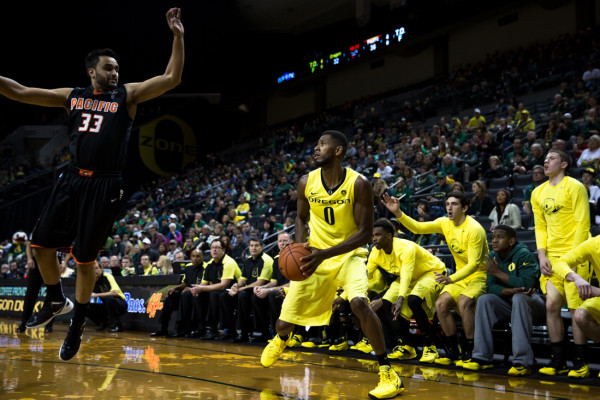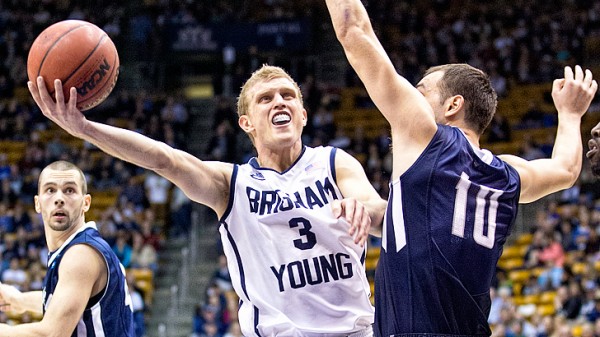Four Keys For Oregon Against BYU Today
Posted by Andrew Murawa on March 20th, 2014Oregon certainly has no shortage of guys that can put the ball in the hoop, with Joseph Young and Jason Calliste among the nation’s most efficient scoring threats. But looking beyond Oregon’s ability to knock in shots from all over the court, below we offer three other keys to Oregon’s chances to advance to the round of 32 by knocking off BYU today.
Mike Moser – For much of Mike Moser’s sophomore season at UNLV, the transfer from UCLA was not only on the very short list of the best players in the Mountain West, but he was in the conversation for All-American consideration. However, his junior year in Vegas was never quite right, with injuries and chemistry problems plaguing him throughout the season. For much of his lone season in Eugene, he looked more like the Moser we saw in his junior season than the one we saw as a sophomore. But then, somewhere in the middle of the season, things began to click for Moser. And, unsurprisingly, it was about the same time things began to click for the Ducks as a whole. Over the course of Oregon’s eight-game winning streak (prior to their Pac-12 quarterfinal loss), Moser averaged 16.6 points and 10.1 boards. And as his offensive game locked in, his focus and effectiveness on the defensive end also improved. In that quarterfinal loss, the passive and ineffective Moser was the rule as he floated around the perimeter offensively and was inattentive and soft defensively. The Ducks will most definitely need the good Moser to show up from here on out in order to survive and advance.
Defense – It is no secret that Oregon’s defense isn’t the college basketball equivalent of the ’84 Bears. They allow better than a point per possession on the season and ranked 93rd in Ken Pomeroy’s adjusted defensive efficiency numbers. But the difference between good Oregon and bad Oregon is pretty startling. In their nine losses, the Ducks have allowed 1.14 points per possession. But even those losses shouldn’t all be taken as equal; Dana Altman has clearly had this team work on their defense throughout the year, so they’re better now than they were at the start of January when they began their mid-season swoon. In those first five consecutive losses, the Ducks allowed 1.19 PPP, a number that would put them squarely in the conversation for worst defensive team in the nation. In the Ducks’ 23 wins, they’ve allowed an average of 0.99 points per possession: certainly not great, but the type of number that can allow the Ducks to win. Now, against a potent offense like BYU’s, odds are good that the Ducks won’t meet that kind of number, but the point is this: Oregon’s defense doesn’t have to be great against the Cougars, but it can’t be awful.
BYU’s Mid-Range Offense – BYU is something of an anomaly. In an era where nearly everyone has begun to recognize that offense efficiency is heavily correlated with taking (and making a good percentage of) most of your shots either from behind the arc or at the rim, the Cougars only attempt 51.2% of their field goals from those areas; the rest (48.8%, good for third in the nation) are two-point jumpers. What’s even more stunning about the Cougars’ approach is that it works for them; they’re the 28th most-efficient offense in Ken Pomeroy’s rankings. The only other team that is in the top 50 of KenPom’s offensive ratings that takes so much as 40% of their shots as two-point jumpers is North Carolina State. What does this mean for Oregon? I’m not entirely sure, just thought it was an eye-popping stat. This percentage will drop some with Kyle Collinsworth out (he shot 54.8% of his FGAs as two-point jumpers), but Oregon will need to recognize that Tyler Haws (he of 61.6% of FGAs two-point jumpers) is not your typical wing that is either trying to drill the three or get to the hoop (although he is perfectly capable of both).
Rebounding and Forcing Turnovers – These are two areas where the Ducks can focus defensively against the Cougars, based on the results of their first game back in December. Back then, BYU was strong on the offensive glass, recovering 45% of their own misses and converting those extra opportunities into 20 points. To tie those first two points together, Moser in particular (with help from guys like Waverly Austin, Ben Carter, Elgin Cook and Richard Amardi) needs to get after the defensive glass and keep Nate Austin and Eric Mika from getting easy opportunities. The second area – turnovers – is a spot where BYU is usually excellent. On the season, they only turn it over on 15% of all possessions, good for 25th in the nation. But against Oregon in December, the Ducks forced 18 turnovers (20.5% turnover rate) and created 22 points off of those turnovers. If Oregon can come close to duplicating the turnover success they had against BYU, while cleaning up the problems they had on the defensive glass, the Ducks could skate. Of course, if the opposite happens (BYU cleans up its turnover problems and duplicates its offensive rebounding), the Ducks could have a short stay in Milwaukee.












































